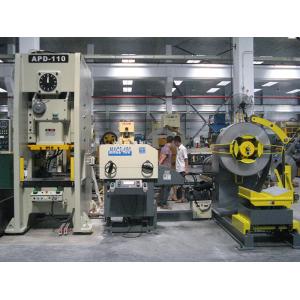

Add to Cart
NC servo feeder performance is stable _ Ruihui high-precision nc
servo feeder _ you can rest assured
The NC servo feeder has stable performance and extremely low
failure rate. It is only the best stamping equipment. In actual
use, the occurrence of faults is still inevitable. The NC servo
feeder is no exception. The most common fault is the unstable
transmission distance. In the event of such a failure, timely
targeted treatment is required to prevent the loss of stamping
production caused by inaccurate feeding.
The unstable transmission distance of the NC servo feeder is also
called infeed, which will greatly affect the quality of the stamped
product; the seven factors that affect the inaccurate feeding:
1. The setting speed of the NC servo feeder is too fast: the NC
servo feeder is not capable of high-speed feeding due to the
response time of the electronic control system. Generally, the
maximum feeding speed of the pneumatic NC servo feeder is 60-120 times per minute ( The specific number varies depending
on the material thickness and step size.) The maximum feeding speed
of the mechanical NC servo feeder is 150-200 times per minute. If
the actual punching speed is higher than this speed, the NC servo
feeder will not keep up. And caused the wrong material.
2. The external air supply pressure is too large or not enough. The
NC servo feeder needs a stable air supply to achieve fast and
stable relaxation. The three-point combination pressure gauge needs
to be adjusted to 4.5kg/cm2. Treatment method: Check whether the
three-point combination pressure gauge is damaged and adjust the
compressor pressure.
3. The feeding height of the NC servo feeder is incorrect. Punch
often needs to be used with multiple sets of different molds. The
height of different molds can also be different. At this time, the
feed height of the feeder should be adjusted after changing the
mold. If the adjustment is not correct, the feed will be skewed and
uneven. Adjust the feed height of the feeder to keep it horizontal
and vertical with the mold.
4. There is an error in the punching die itself or no material
trimming. If there is a problem in the design and production of the
punching die itself, the feeding distance will be unstable. At this
time, the NC servo feeder can be used for feeding, but the manual
manual feeding is used to test the product to confirm whether the
problem is on the mold itself. Modification can be done.
5. There is stamping oil on the feeding roller of NC servo feeder.
Stamping production In order to prevent the long-term friction
between the material and the mold, the die life is damaged and the
punching accuracy is not accurate. Usually, the material is stamped
with oil before the material enters the mold. If the punching oil
enters the feeding roller, the feeding slip will be inaccurate. At
this time, the feed roller can be cleaned and wiped.
6. The feeding time of the NC servo feeder is set incorrectly.
Different molds have different feeding time requirements for the
feeder. If the feeding time is set too late, the feeding will be
insufficient. At this time, the feeding signal cam angle of the
punching machine needs to be re-adjusted.
7. The NC servo feeder's relaxation time is incorrect. If the
relaxation time is not correct, the material feeding will not be in
place or the material will retreat. At this time, the angle of the
relaxation signal cam of the punching machine needs to be
re-adjusted.
Specification:
| Model | MAC2-400 | MAC2-500 | MAC2-600 | MAC2-800 | ||
| Stock Width(mm) | 50-400 | 50-500 | 50-600 | 50-800 | ||
| Stock Thickness(mm) | 0.3~3.2 | 0.3-3.2 | 0.3-3.2 | -3.2 | ||
| Max.Coil Weight(kg) | 3000 | 3000 | 3000 | 5000 | 5000 | 7000 |
| Max.Coil O.D.(mm) | 1200 | 1200 | 1200 | |||
| Coil I.D.(mm) | 8 | 8 | 508 | 508 | ||
| Feed Length(mm) | ~500* | ~500* | ~500* | ~500* | ||
| Max. Line Speed(m/min) | 16-24 | 16-24 | 16-24 | 16-24 | ||
| Work Roll Number(pieces) | upper 6 lower 5 | upper 6 lower 5 | upper 6 lower 5 | upper 6 lower 5 | ||
| Feed Roll Number(set) | 1 | 1 | 1 | 1 | ||
| Main Motor(kw) | AC2.9 | AC2.9 | AC4.4 | AC4.4 | ||
| Mandrel Expansion | hydraulic | hydraulic | hydraulic | hydraulic | ||
| Reel Motor(kw) | 1.5 | 1.5 | 1.5 | 2.2 | 2.2 | 3.7 |
| Power(V) | 3 Phase 220V/380V/50HZ | |||||
| Operating Air(Mpa) | 0.49 | 0.49 | 0.49 | 0.49 | ||
Straigtening performance:
| tock Thicknees (mm) | Stock Width (mm) | |||
| 0.3 | 400 | 500 | 600 | 800 |
| 0.4 | ||||
| 0.6 | ||||
| 0.8 | ||||
| 1.0 | ||||
| 1.2 | ||||
| 1.4 | ||||
| 1.6 | 470 | 470 | ||
| 1.8 | 400 | 400 | ||
| 2.0 | 360 | 360 | ||
| 2.3 | 300 | 300 | 300 | 300 |
| 2.5 | 230 | 230 | 230 | 230 |
| 2.8 | 150 | 150 | 150 | 150 |
| 3.2 | 110 | 110 | 110 | 110 |
*1:(Pneumatic):Option in case of pneumatic mandrel expansion is
provi
